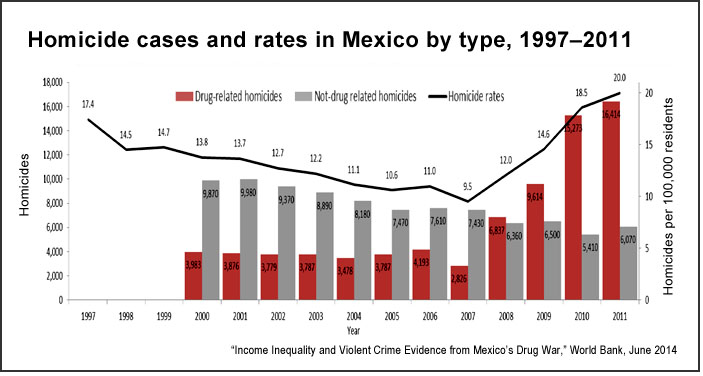
Mexico’s “drug war” resulted in an estimated 60,000 deaths between 2006 and 2012, with another 26,000 Mexicans missing as a result of the violence. Felipe Calderon, the country’s president during that period, targeted the leaders of drug cartels, but the strategy reportedly led to a violent competition between gangs to consolidate power within a multi-billion-dollar industry. At the same time, the falling drug trade encouraged criminal organizations to turn to crimes such as kidnappings, extortion and domestic drug dealing to boost profits.
While the number of drug-related homicides has begun to plateau or decline under President Enrique Peña Nieto, elected in 2013, violence remains endemic in parts of Mexico. (It is worth noting that all aggregate data relating to this conflict may have underlying problems, as collection has not been systematic or consistent.) Across Central America, violent crime is estimated to cost as much as 8% of GDP. It also contributes to migration, with victims of crime 30% more likely to consider moving to the United States. Of particular concern is the recent surge in unaccompanied child migrants attempting to cross the Mexican border. While much of this increase has been driven by rising violence in other Central American countries, Mexico still accounted for about one-quarter of the unaccompanied children detained.
A 2014 World Bank paper, “Income Inequality and Violent Crime: Evidence from Mexico’s Drug War,” used 20 years of local-level data covering more than 2,000 Mexican municipalities to estimate the impact of changing inequality on crime rates, before and during Mexico’s drug war. Researchers have previously linked rising inequality with increased violent crime: The argument goes that poverty and inequality can cause social tension that increases violence. From a cost-benefit point of view, the payoffs from crime are also greater in more unequal societies, while the potential cost — the odds of being caught or having to bribe the police to avoid arrest, for example — is lower. However, empirical evidence has produced varying results and a causal link between the two has not been definitively established. Furthermore, evidence from Central and South America would seem to contradict the theory, as inequality has fallen across the region at a time when violent crime has surged in many places.
The study’s authors — Ted Enamorado of Princeton University and Luis-Felipe López-Calva, Carlos Rodríguez-Castelán and Hernán Winkler of the World Bank — note that while 90% of municipalities in Mexico experienced a decline in income inequality between 1990 and 2005, that figure fell to 78% of municipalities from 2005 to 2010. Therefore, despite an overall decline in the Gini coefficient (a commonly used measure of inequality) at the national level, many municipalities experienced an increase in inequality during these periods.
The study’s findings include:
- From 1990 to 2005, the total rate of homicides in Mexico followed a downward trend. However, the picture reversed from 2005 to 2010, when the rate of homicides increased from 11 deaths per 100,000 individuals to 18 deaths per 100,000.
- Initial analysis indicated that falling inequality was linked with rising crime rates. However, this did not account for other factors affecting both trends: For example, rising crime rates may cause a reduction in inequality as wealthier residents leave for safer municipalities. When the researchers controlled for these factors, they found that rising inequality was associated with higher rates of violent crime. For the period from 2005 to 2010, a one-unit increase in the Gini coefficient translated into nearly five additional deaths per 100,000 individuals.
- This effect is larger when the researchers focused on just drug-related crimes. In these cases, a one-unit increase in the Gini coefficient is associated with an increase of more than 10 deaths. In contrast, prior to 2005, an increase in the Gini coefficient did not affect crime rates.
The results of the study show that “the combination of lower costs (associated with the expansion of drug gangs) and rising pecuniary benefits of criminal activity (associated with increasing inequality) that has a large impact on crime rates.” Mexico’s drug war, and the associated lower costs of criminal activity, therefore had an important effect in shaping the effects of income inequality on criminal activity. Finally, the researchers note that the majority of municipalities experienced a decline in income inequality over the period studied; this suggests that the increase in drug-related crimes may have been even more dramatic if Mexico had not experienced such improvements in many regions.
Keywords: crime, violence, drugs, Mexico

